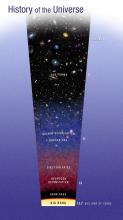Listen to today's episode of StarDate on the web the same day it airs in high-quality streaming audio without any extra ads or announcements. Choose a $8 one-month pass, or listen every day for a year for just $30.
You are here
More Antimatter
Fictional starships notwithstanding, there’s not much antimatter in the universe. And for us, that’s a good thing. Any time matter and antimatter meet, they cancel each other out in a blaze of energy.
Antimatter is identical to normal matter in almost every way. The only difference is electric charge, which is opposite for the two forms of matter. So there could be a whole galaxy made of antimatter out there and our telescopes wouldn’t see it any differently from a galaxy of normal matter.
Most theories say the Big Bang should have created equal amounts of matter and antimatter. But in the first tiny fraction of a second, something changed that balance. For every billion pairs of matter and antimatter particles, there was one extra particle of matter.
One of the first scientists to consider that imbalance was Andrei Sakharov. He’d helped develop the Soviet hydrogen bomb, but turned away from weapons work. In a paper published more than 50 years ago, he outlined conditions that could create the imbalance.
Sakharov said that protons must decay, but so slowly that it’s almost impossible to detect. Second, he said that the universe must have cooled in a certain way in the moments after the Big Bang. And finally, he said there must be some difference between matter and antimatter.
So far, none of those conditions has been confirmed, so the subject of matter versus antimatter remains a busy topic of research.
Script by Damond Benningfield




